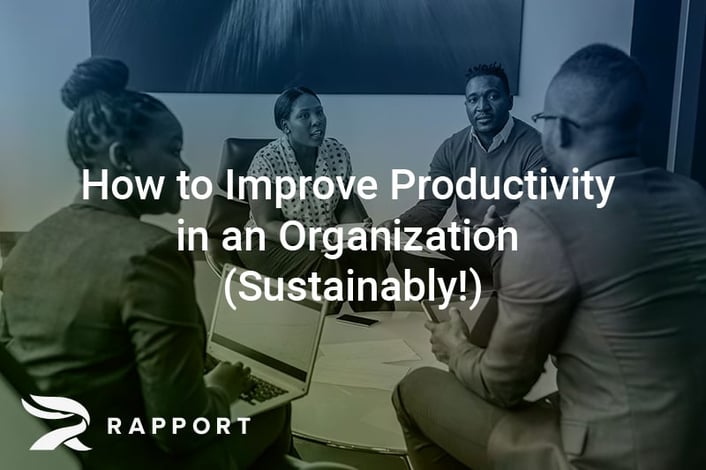How to Improve Productivity in an Organization (Sustainably!)

Whether you’re managing a team or managing yourself, increased productivity helps to improve your business.
When employee productivity is high, it’s not usually on your radar. However, when productivity is low, all sorts of issues arise. You may be seeing deadlines missed or projects not done properly. Your employees may be frustrated, and you may be experiencing high levels of stress in your day. When your productivity is low, you may feel like you’re chasing your own tail, working harder and harder and not seeing the returns you want.
As productivity dips, you begin to see other issues. Your bottom line suffers; your employees are dissatisfied and disengaged. Sick days and turnover may increase, and your organizational culture as a whole takes a hit.
You realize that it’s important to improve both your and your team’s productivity; you’re just not entirely sure how to do that.
Our personal development courses and retreats are great choices. Check them out →
How to Improve Productivity in an Organization
While for some, the term “increased productivity” suggests milking your employees for everything they’re worth, it’s not about that. Employees are every organization’s biggest asset, and while you want them to be productive, you don’t want them to become resentful of you or the company as a whole and eventually burn out.
Being productive means that you work efficiently when you’re on a task, but it also requires downtime and self-care. Below, we’ll discuss what factors affect productivity and some strategies you may implement within your own organization to ensure that your employees are happy, healthy, and productive.
Factors that Increase Productivity
Within any organization, there are a number of factors that will either increase or decrease productivity. Understanding these factors will help you better strategize for improvements.
Environment
While you may assume that employee workspace is a good place to skimp and save money, that's far from the truth. Fluorescent lights, freezing cold offices, and gray, drab cubicles no longer cut it. Employees work best between 68 and 70 degrees F. While overhead lighting is important, being near natural light improves moods. Adding plants to the office will improve air quality and make your employees smile.
Equipment
If you spend time waiting for your computer to boot up in the morning or you’ve ever seriously considered taking a baseball bat to the copy machine, it may be time for an equipment upgrade. Equipment that is old and slow or constantly breaking down takes time away from employees’ tasks and projects.
Policies and Procedures
Take a look at the procedures you’ve laid out for your team. Are there any tasks that are repetitive, are unnecessary, or which may be automated or delegated? Oftentimes, employees aren’t efficient because the procedures they are required to follow aren’t efficient.
Proper Training
When you haven’t properly onboarded and trained your employees, they’ll struggle with completing projects efficiently and on time. Ensuring (up front) that they receive all the training they need to do their jobs properly will actually save you time and money in the long run.
Productivity Improvement Strategies in Business
Now that you understand some of the factors that go into a productive organization, what strategies will you implement in your own business?
Create a warm and inviting work space.
Give employees access to natural light, a comfortable temperature, the option to listen to music (if they feel it helps them), comfortable seating, a break room that’s inviting and encourages time off and socialization, and an efficient work space where everything they need is within reach. Even something as simple as moving the supply closet closer will help employees spend more time working on projects.
Provide the right equipment and training.
Ensure that your equipment is as new and functional as possible and that employees have the necessary skills and tools to do their jobs efficiently. If you don’t have the necessary training within your organization, consider sponsoring employees to take necessary workshops and retreats outside of the office.
Make it easy for employees to communicate with you and with one another.
Technology has made communication even easier and given business owners multiple avenues for communicating with employees and fostering communication between team members. Provide a few options for your employees to voice their concerns, brainstorm solutions, communicate with one another on projects, and create a tight-knit team. You’ll also want to teach your employees what type of communication is best (and sometimes required) depending on the type of conversation.
Give employees freedom to manage themselves.
Nothing makes an employee’s productivity swirl down the toilet like being micromanaged. Provide employees with enough leeway to work as they function best. Some individuals and some generations prefer more supervisor involvement, while others want the space to work and then to deliver the finished product without interruption. Find out how they want to be managed and respect that if at all possible.
Set goals.
Is it possible that your employees don’t know what “productive” means in your organization? Without setting goals and reviewing them with each employee, they may not understand what is expected of them. Sit down with your team members and explain what their job description entails, how you’d like them to perform, and what goals you’d like them to reach.
Show appreciation with praise and rewards.
If employees don’t receive anything for a job well-done (besides more work, of course), they are less likely to perform efficiently. Productivity increases when employees know that they have done a good job, are thanked for their hard work, and, when possible, receive (even a token) gift for being productive and successful.There are many ways to increase productivity in your organization. Take the time to identify the challenges that your employees are facing, and you will be able to create a better plan of attack. Once you understand what the issue is, use the above strategies to help your employees become as engaged and productive as possible.



